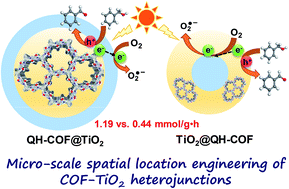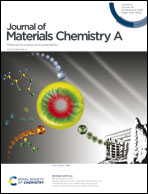Micro-scale spatial location engineering of COF–TiO2 heterojunctions for visible light driven photocatalytic alcohol oxidation†
Abstract
Herein, we report the design and fabrication of QH-COF@TiO2 and TiO2@QH-COF (QH-COF: tetrahydroquinoline-linked COFs) core–shell structured heterojunctions for photocatalytic oxidation of alcohols. For the first time, the spatial location of two semiconductors either in the core or on the shell is precisely designed, and their corresponding photocatalytic performance has been well investigated. For photocatalytic benzyl alcohol oxidation, the activity of QH-COF@TiO2 is almost three times higher than that of TiO2@QH-COF (reaction rate: 1.19 vs. 0.44 mmol g−1 h−1), although they exhibit similar capability for light harvesting and charge separation. The higher photocatalytic activity of QH-COF@TiO2 is due to its easier donation of electrons to O2. A similar tendency was also observed for the visible-light photocatalytic aerobic cross-dehydrogenative coupling reaction. Our spatial location engineering of semiconductor heterojunctions provides an efficient strategy that facilitates the modulation of charge separation and mass diffusion to enhance the photocatalytic activity of semiconductors.



 Please wait while we load your content...
Please wait while we load your content...